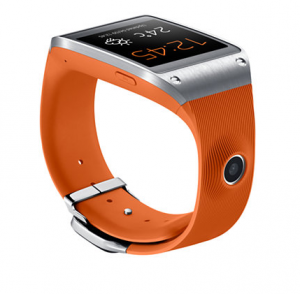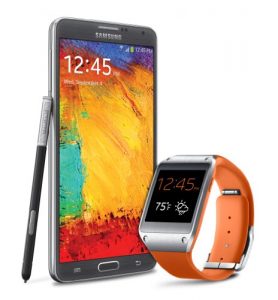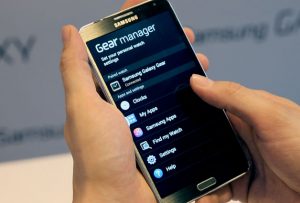For all intents and purposes the Samsung Galaxy Gear can be considered the polar opposite of the Pebble. The Pebble is open when it comes to software and customization. The Galaxy Gear on the other hand, is not.
It makes use of a proprietary band – complete with an integrated camera – that cannot be swapped out. It’s running a forked version of Android that can’t really be customized, at least not in the way most Android users have come to know.
Worse yet, it’s only compatible with a handful of Samsung branded devices. In other words, not everyone is going to be able to board the Galaxy Gear train. That’s okay, because there are plenty of other devices on the market for everyone else – that is, everyone not interested in purchasing a compatible device and Galaxy Gear together if they don’t already own the former.
All of that aside it’s a great device, albeit with some pretty glaring limitations. Our Samsung Galaxy Gear review will help point out the good and the bad.
Overview
| Samsung Galaxy Gear Review | |
| Overall: (3/5) | |
| Build: (4/5) | |
| Design: (4/5) | |
| Customization: (3/5) | |
| Functionality: (4.5/5) | |
| Compatibility: (2/5) | |
The Galaxy Gear does have a pretty attractive design. I can honestly say that pictures – even high res ones – don’t do the thing justice. The metallic bezel, square form factor and colorful arm bands are more than appealing to say the least. It feels pretty sturdy in hand too, but we’ll get to that in more detail in the build section below. Samsung has always excelled when it comes to displays. They make great TV displays, brilliant smartphone displays and if the Galaxy Gear is any indication they will continue the trend with their smartwatch models in the present and future. The Gear sports a 1.63” super AMOLED display with a resolution of 320×320, which is fantastic for a smartwatch. Moving past the geeky screen spec sharing, the Gear also sits comfortably on the wrist. As I so clearly outlined in the intro, the biggest issue with the Gear is its limitations. For most people, Galaxy lovers included, that won’t pose a problem. If the Galaxy Gear were compatible with more devices, I would score it much higher in that respect.
- Overall: 3/5 – Samsung’s Galaxy Gear is a great smartwatch and it does exactly what you’d expect it to, but there are some serious compatibility issues holding it back from being truly great.
Build
 The device itself feels pretty sturdy in-hand. The stainless steel chassis means it’s likely more susceptible to unwarranted force, but it’s not indestructible so it can definitely be scuffed or scratched.
The device itself feels pretty sturdy in-hand. The stainless steel chassis means it’s likely more susceptible to unwarranted force, but it’s not indestructible so it can definitely be scuffed or scratched.
The display is protected by Corning Gorilla Glass, so it should do just fine. The latter feature is important, because you’d be surprised at what you can accidentally smack the watch on while your wrist flails about. The rubberized band is really the biggest thing to worry about when considering the durability of the Gear, but even it can handle a great deal of stress. It would certainly have to anyway, as it includes the device speaker and a camera sensor built-in. As a matter of fact, without the band the device probably wouldn’t work.
It’s clear that Samsung designed and manufactured the Gear as one seamless piece of hardware from watchface, to band to clasp. It’s not quite as durable as say the Pebble Steel, but it’s certainly much better than the plastic version of the same watch brand.
The Galaxy Gear design is much more appealing than the original Pebble, and a bit sturdier too – at least when it comes to the stainless steel watchface. The Gear is splash proof, which means you can’t take it in the shower but if you spritz a little water on it – or drool – it should still work just fine. This is also great because it’s much easier to clean, and anything with a touchscreen has a penchant for getting pretty greasy and grimy. If you don’t like stainless steel, you won’t like the Galaxy Gear.
If you want a nigh indestructible device, you should definitely look elsewhere. Otherwise the Gear is great when it comes to build quality.
- Build: 4/5 – The overall build quality is fantastic, but there are some questionable elements such as the rubberized (and proprietary) wristband.
Design
The Samsung Galaxy Gear actually happens to be one of the more stylish options on the market – at least it will remain that way until the new Android Wear devices launch. The watch face and main chassis have been constructed with stainless steel. The contoured shape of the device ensures that it sits comfortably on ones wrist, and the rubberized wristband is acceptable. The AMOLED touchscreen is protected by Gorilla Glass, which means fewer scratches and visible damage.
That’s particularly great because the 1.63” 320×320 display is quite beautiful, albeit even without HD. What really matters about the screen is that you can see it clearly in sunlight, which is important for a primary time-telling device. Along the sides you’ll find a physical home button and a mic. On the underside is the charging port. On the top of the wristband you’ll find the camera sensor. Also on the wristband, more specifically near the clasp you’ll find a small speaker. These placement features mean that the band is proprietary and cannot be removed, swapped out or modified. It’s a shame because the device would really look great with a custom leather band. The biggest issue is the camera, not because it doesn’t work properly but because it was unnecessary.
To accommodate for the odd shooting angle of a camera on a smartwatch, Samsung placed the sensor on the wristband. If you have the watchface positioned on the top of your wrist so you’re looking at it, the camera faces forward. Actually capturing photos with the camera is not difficult, and it’s not as awkward as one would expect it to be.
The real problem is that the bulge detracts from the sleek design of the device. As for the main watchface, the only thing that takes away from the overall design is the unsightly placement of four screws. I wouldn’t say it necessarily makes the device any uglier, but it is an aesthetic element that could have easily been avoided or implemented better.
- Design: 4/5 – minor nuances aside the Gear is actually one of the better looking smartwatches on the market, but that also depends on which color you choose (some of the band styles are horrendous)
Customization
 The Galaxy Gear is running a custom version of Android with Samsung Touchwiz like skins. In the tech world we refer to it as a “forked” version of Android because it has essentially been tampered with by the manufacturer. In this case, it’s warranted because Android was certainly never designed with small screen devices like the Gear in mind.
The Galaxy Gear is running a custom version of Android with Samsung Touchwiz like skins. In the tech world we refer to it as a “forked” version of Android because it has essentially been tampered with by the manufacturer. In this case, it’s warranted because Android was certainly never designed with small screen devices like the Gear in mind.
That being said, Samsung also made it much more difficult to customize the device when compared to something more open like the Pebble. So, what can you customize? You can install apps, personalize the gestures and control functions, change the font size and even create custom watchfaces through third party apps.
For the most part however, what you see when you first turn on the device is what you get it. You can purchase the Gear in several color variants, which really just means you’re getting a different wristband color. Unfortunately, the band itself cannot be changed or swapped out primarily due to the fact that it’s part of the main device and includes integrated hardware such as a camera sensor and speaker.
When it all boils down, there’s not much you can do with the Galaxy Gear to really personalize it and make it your own. That’s not necessarily a big issue for most, but it is something you need to consider. If you don’t really care about customization then you can pass over this section and continue on with the review.
- Customization: 3/5 – most of the personalization changes are software based, but you have to look to third party apps to create custom watchfaces otherwise what you see is what you get
Functionality
 As for additional hardware, the Gear includes a micro-USB cord and charging cradle which is the only way to charge the device once the battery has worn down (obviously). Specs include an 800MHz processor combined with 512MB of RAM. The device sports 4GB of storage, Bluetooth and several other components like an accelerometer and gyroscope. NFC functionality allows you to quickly and easily pair the device to your Note 3, or similarly compatible Samsung smartphone.
As for additional hardware, the Gear includes a micro-USB cord and charging cradle which is the only way to charge the device once the battery has worn down (obviously). Specs include an 800MHz processor combined with 512MB of RAM. The device sports 4GB of storage, Bluetooth and several other components like an accelerometer and gyroscope. NFC functionality allows you to quickly and easily pair the device to your Note 3, or similarly compatible Samsung smartphone.
It is worth noting that the measly 315mAh battery will only last for about a day, even less under serious use so you’ll need to charge the device frequently. Once the device is all paired up, you have to do everything through an official app called Gear Manager. It is the holy grail of the Gear, as you can customize settings, install or remove apps, and much more.
When it comes to the user experience, it can be confusing at first but after a while you get used to it. The Gear UI is actually pretty great it’s one of the device’s highlights. Of course, it’s not perfect and some flaws definitely stand out but the real point is that the device is pretty accessible. When the screen turns on the first thing you generally see is the clock, unless you had an app open the last time the screen timed out.
From the general screen you can swipe up to get to the dialer and make a call, swipe down to snap a photo with the camera, or swipe left and right to access apps. Tapping the screen with two fingers and holding will open a complete apps list, while using two fingers to double tap will show battery percentage and simple settings. Long story short, it’s easy enough to use and that’s important. When it comes to added functionality the Gear pairs well with a compatible Samsung device and you can receive all notifications and make calls from it. For lack of a better phrase, it does exactly what you’d expect a smartwatch to do.
- Functionality: 4.5/5 – it does exactly what you’d expect a smartwatch to do, nothing more yet nothing less
Compatibility
This is where the Gear is really going to get docked in terms of score. It’s not compatible with a lot of devices, only Samsung branded handsets to be precise. More importantly, it’s not even compatible with a wide variety of Samsung handsets – only a select few. By all rights the Galaxy Gear should be considered one of the most the exclusive devices of the year – VIP members only. That being said, Samsung holds the most market share when it comes to mobile owners. If you own a compatible Samsung device the Gear works great, otherwise you’re out of luck. To see compatible Samsung devices check out the official and up-to-date list here.
- Compatibility: 2/5 – the Galaxy Gear is only compatible with a select few Samsung branded handsets, and that’s it
Conclusion
While the Galaxy Gear is in the running to be one of the best smartwatches on the market currently, there’s one glaring issue – it’s only compatible with a small handful of Samsung handsets. That means unless you’re packing one of Samsung’s latest and greatest, you should be looking elsewhere. The design is appealing, the build quality is great and the necessary functionality is all there. You even have some pretty standard personalization options if you want to make the Gear your own. There are some flaws here and there but overall it’s a great device – if you can actually use it. You will need a paired smartphone to take full advantage of the Gear, so don’t pick one up thinking you can use it without one. For $249, there are better ways you could be spending your money.
We hope you enjoyed our Galaxy Gear review and it proved useful in your search for the perfect smartwatch. Stay tuned for our coverage of the Galaxy Gear 2!
